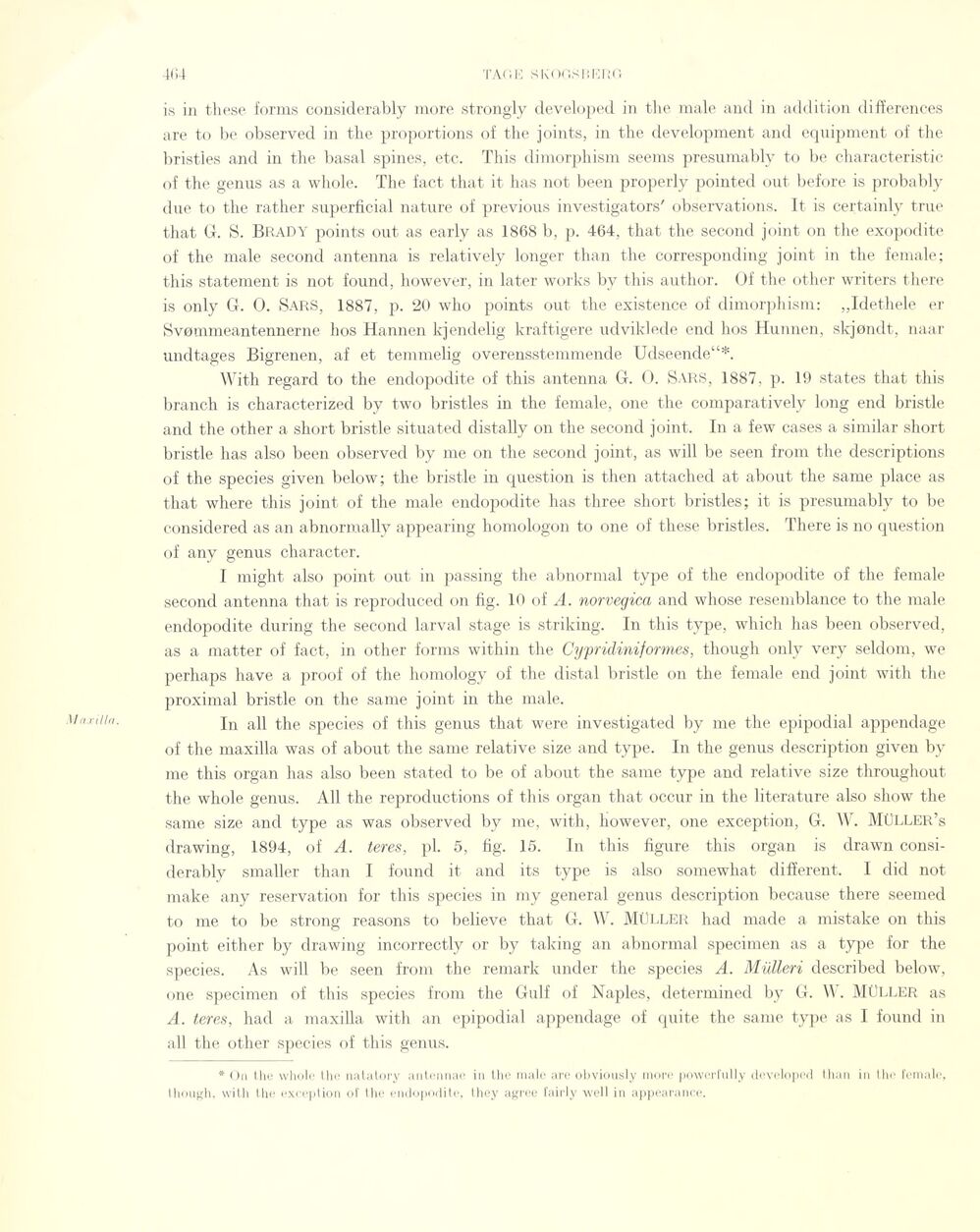
Full resolution (JPEG) - On this page / på denna sida - Sidor ...

<< prev. page << föreg. sida << >> nästa sida >> next page >>
Below is the raw OCR text
from the above scanned image.
Do you see an error? Proofread the page now!
Här nedan syns maskintolkade texten från faksimilbilden ovan.
Ser du något fel? Korrekturläs sidan nu!
This page has never been proofread. / Denna sida har aldrig korrekturlästs.
Maxilla.
is in these forms considerably more strongly developed in the male and in addition differences
are to be observed in the proportions of the joints, in the development and equipment of the
bristles and in the basal spines, etc. This dimorphism seems presumably to be characteristic
of the genus as a whole. The faet. that it has not been properly pointed out before is probably
due to the rather superficial nature of previous investigators’ observations. It is certainly true
that G. S. Brady points out as early as 1868 b, p. 464, that the second joint on the exopodite
of the male second antenna is relatively longer than the corresponding joint in the female;
this statement is not found, however, in later works by this author. Of the other writers there
is only G. 0. Sars, 1887, p. 20 who points out the existence of dimorphism: ,,Idethele er
Svømmeantennerne hos Hannen kjendelig kraftigere udviklede end hos Hunnen, skjøndt, naar
undtages Bigrenen, af et temmelig overensstemmende Udseende“*.
With regard to the endopodite of this antenna G. 0. Sars, 1887, p. 19 states that this
branch is characterized by two bristles in the female, one the comparatively long end bristle
and the other a short bristle situated distally on the second joint. In a few cases a similar short
bristle has also been observed by me on the second joint, as will be seen from the descriptions
of the species given below; the bristle in question is then attached at about the same place as
that where this joint of the male endopodite has three short bristles; it is presumably to be
considérée! as an abnormally appearing homologon to one of these bristles. There is no question
of any genus character.
I might also point out in passing the abnormal type of the endopodite of the female
second antenna that is reproduced on fig. 10 of A. norvegica and whose resemblance to the male
endopodite during the second larval stage is striking. In this type, which has been observed,
as a matter of faet, in other forms within the Cypridiniformes, though only very seldom, we
perhaps have a proof of the homology of the distal bristle on the female end joint with the
proximal bristle on the same joint in the male.
In all the species of this genus that were investigated by me the epipodial appendage
of the maxilla was of about the same relative size and type. In the genus description given by
rne this organ has also been stated to be of about the same type and relative size throughout
the whole genus. All the reproductions of this organ that occur in the literature also show the
same size and type as was observed by me, with, however, one exception, G. W. MÜLLER’s
drawing, 1894, of A. teres, pi. 5, fig. 15. In this figure this organ is drawn
considerably smaller than I found it and its type is also somewhat different. I did not
make any reservation for this species in my general genus description because there seemed
to me to be strong reasons to believe that G. W. Müller had made a mistake on this
point either by drawing incorrectly or by taking an abnormal specimen as a type for the
species. As will be seen from the remark under the species A. Mulleri described below,
one specimen of this species from the Gulf of Naples, determined by G. W. MÜLLER as
A. teres, had a maxilla with an epipodial appendage of quite the same type as I found in
all the other species of this genus.
* On I hu vvholu thu imlatory antennae in the male are obviously more powerfully developed than in the female,
though, with the exception of the endopodite, they agree fairly well in appearance.
<< prev. page << föreg. sida << >> nästa sida >> next page >>